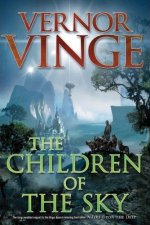
| The Children of the Sky | ||||||||
| Vernor Vinge | ||||||||
| Tor, 444 pages | ||||||||
|
A review by Greg L. Johnson
When those doubts break open and spur a rebellion, no one is more surprised than Ravna, the only adult human
survivor from the story that Vernor Vinge began in A Fire Upon The Deep. Ravna is a librarian, an
organizational genius with no social and political skills whatsoever, and her education in the ways of her
fellow humans is both humbling and enlightening. Ravna is the one with personal knowledge of the danger the
Blight represents. If she doesn't learn how to persuade, rather than order, the children who were left in
her care, all could be lost.
That dilemma says a lot about what kind of novel The Children of the Sky is. While the story picks
up almost immediately after the end of A Fire Upon The Deep, the setting and focus of
the The Children of the Sky is much different. In addition to the approaching Blight, the humans
on Tine's World have the problem of relating to the native inhabitants, the dog-like Tines and their pack
mentality. With both human and Tine scheming and politics involved, The Children of the Sky more closely
resembles one of C.J. Cherryh's many novels involving human and alien interactions and Vinge's own
A Deepness In The Sky than it does the far-reaching sweep and cosmic setting of A Fire Upon The Deep.
While some may find that disappointing, it is a necessary development in the story. At the end of
A Fire Upon The Deep, the Blight had been slowed down, but possibly not destroyed, while on Tine's
World, one adult woman and a shipload of children were stranded amongst an alien civilization with
medieval-level technology. If the Blight reaches them too fast, what's left of humanity is gone in an
instant. The Children of the Sky, then, is a necessary chapter in the story, but one that leaves
the big questions to be answered in a later volume.
That does mean The Children of the Sky is a bit of a place holder. There's also a structure that
concentrates on the human issues, leaving the wish that more time had been spent on the Tines, who play at
least a great a role in the outcome of the novel as the humans. Those faults make The Children of the Sky
a bit less satisfying than its immediate predecessors.
Which is to say that it's not quite as good as two of the best science fiction novels of the last twenty
years. The Children of the Sky may not rank that high, but it's still a good book with believable
characters, a story that needed to be told, and a promise that there is a bigger story yet to come.
Reviewer Greg L. Johnson regrets that he has but one life to live in the Slow Zone. Greg's reviews have appeared in publications ranging from The Minneapolis Star-Tribune to the The New York Review of Science Fiction. And, for something different, Greg blogs about news and politics relating to outdoors issues and the environment at Thinking Outside. | |||||||
|
|
If you find any errors, typos or other stuff worth mentioning,
please send it to editor@sfsite.com.
Copyright © 1996-2014 SF Site All Rights Reserved Worldwide
